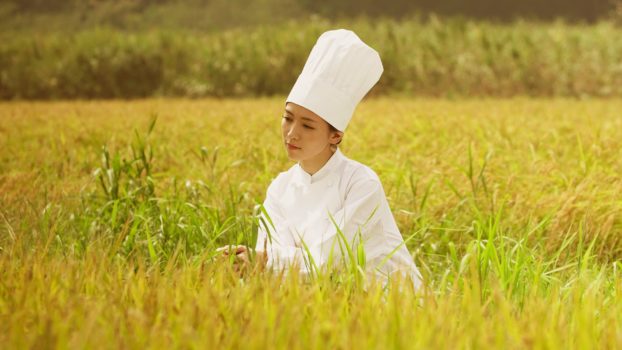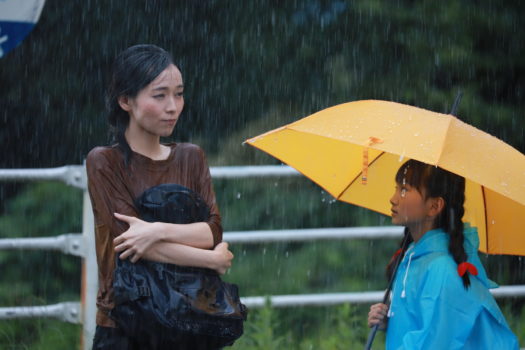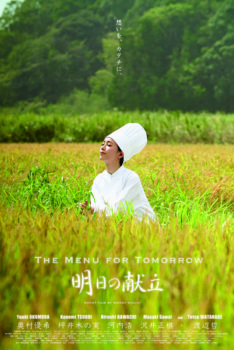
The Menu for Tomorrow
“The menu selection meeting for OUR tomorrow”
“The Menu for Tomorrow” is a short film by Kazuhiro Kiuchi. Runtime – 20 minutes.
Synopsis
Reiwa Wedding Hall is one of the popular wedding halls in Tokyo. Their new chef, Saki, is always busy planning new menus.
However, one day, something unusual happens.
In the middle of the menu selection meeting, Ishimori working in sales department rushes in as he receives one request about the menu from his customers.
The manager and the master chef get puzzled by the news. It brings back memories of the Great East Japan Earthquake and Fukushima. After a lot of thought, Saki decides what to serve in the wedding party.
Director Biography
Kazuhiro Kiuchi was born in Tokyo. He used to be the Representative Director of Sanyo Seiko, Co., Ltd. He started making films when he was in his 40s. While staying in Los Angeles for two and a half years on business, he studied architectural CAD software programs, three-dimensional computer graphics (3D-CG), and films in general. While studying at UCLA Extension, he wrote a script for a short film in a class. He directed a short film for the first time using it as the script with the cooperation of his friends in LA. It won a prize in Tokyo Video Festival.
After coming back to Japan, he made his second short film “Green Tea-r”, which showed what his mother had experienced when the atomic bomb had been dropped on the city. It won the grand prize in the Takarazuka Film Festival, was screened over 100 times in the film festivals held in more than 10 countries, including Berlin International Film Festival.
His first feature-length film “Sun Flower – Himawari” was shot right after the Great East Japan Earthquake. It won the grand prize in the Kashikojima Film Festival. It was screened in many film festivals including the Cannes Film Festival, and got favorable reviews.

The Menu for Tomorrow
Director’s Statement
Initial idea
When I went to a film festival in Okinawa in 2012, I was told this by the owner of one cafeteria; “When I buy rice for business use in Okinawa, it’s usually from Fukushima”. This was quite surprising for me.
According to my research, Okinawa is the farthest prefecture from Fukushima in Japan, but for some reason, cheap rice from Fukushima always sells the best.
Fukushima rice, even if tested carefuly against radiation contamination, is not popular nationwide. Apart from Okinawa, there is no demand for this rice. Does this mean that there is a lack of awareness?
I decided that I must make a film based on this phenomenon.
Wedding hall
In Japan, it is popular to hold a ceremony at a wedding hall.
It is common for a Christian church and a Shinto temple to co-exist together on the same site. The Japanese are simply not bothered by it – two gods can live together in the same place. I chose it as a location because I thought it represented the Japanese view of religion well. And it was also my intention that to make a film that anyone in the world could see.
Hiroshima / Nagasaki
My great-grandfather was the mayor of Nagasaki City (then Higashi Nagasaki City).
I have always lived an uncomfortable life as a second-generation hibakusha (2nd generation of A-bomb survivors). And today, children of Japan also experience these same feelings. I think that such remorse made this work.
Reaction in Japan
The reception of “Tomorrow’s Menu” in Japan was not good. It was nominated and has won 21 awards at 43 film festivals in 22 countries around the world since it was released in 2020. But I have never won a film festival competition in Japan.
I think that the reason is that the nuclear and Fukushima nuclear power plant issues are highly politicized in Japan. Therefore, I would like everyone from overseas to see and monitor the current situation in Japan.
Rice balls
When I was a child, my mother was strict. She was very kind only when I had nosebleeds. Even if I protested, she took me to the hospital and made rice balls for me instead of letting me eat the school lunch.
Now I start to think it was so because my mother was remembering neighbors who put out a lot of bleeding and died in Nagasaki A-bomb.
And I think that the act itself was sad, warm, and mother’s love – although it was also based on ignorance.
“The Menu for Tomorrow” is my mother’s love itself.
Radioactivity measurement room Hakaruwakar
It is a radiation measurement room in Tokyo, which was established in 2011 and is operated only by private volunteers. It is still active.
Hakaruwakaru – 八王子市民放射能測定室 – ハカルワカル広場 (hachisoku.org)

The Menu for Tomorrow
Facebook page of “The Menu for Tomorrow” – Short Film “明日の献立 The Menu for Tomorrow” | Facebook
